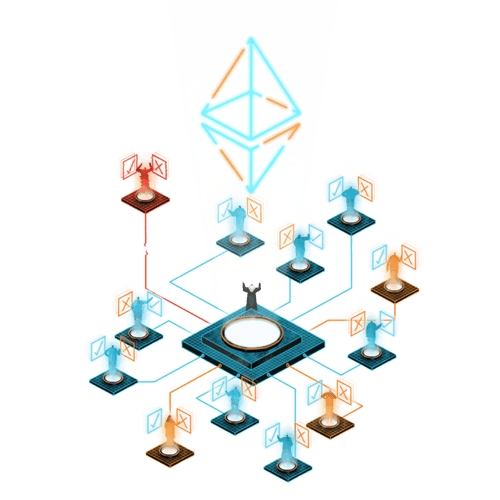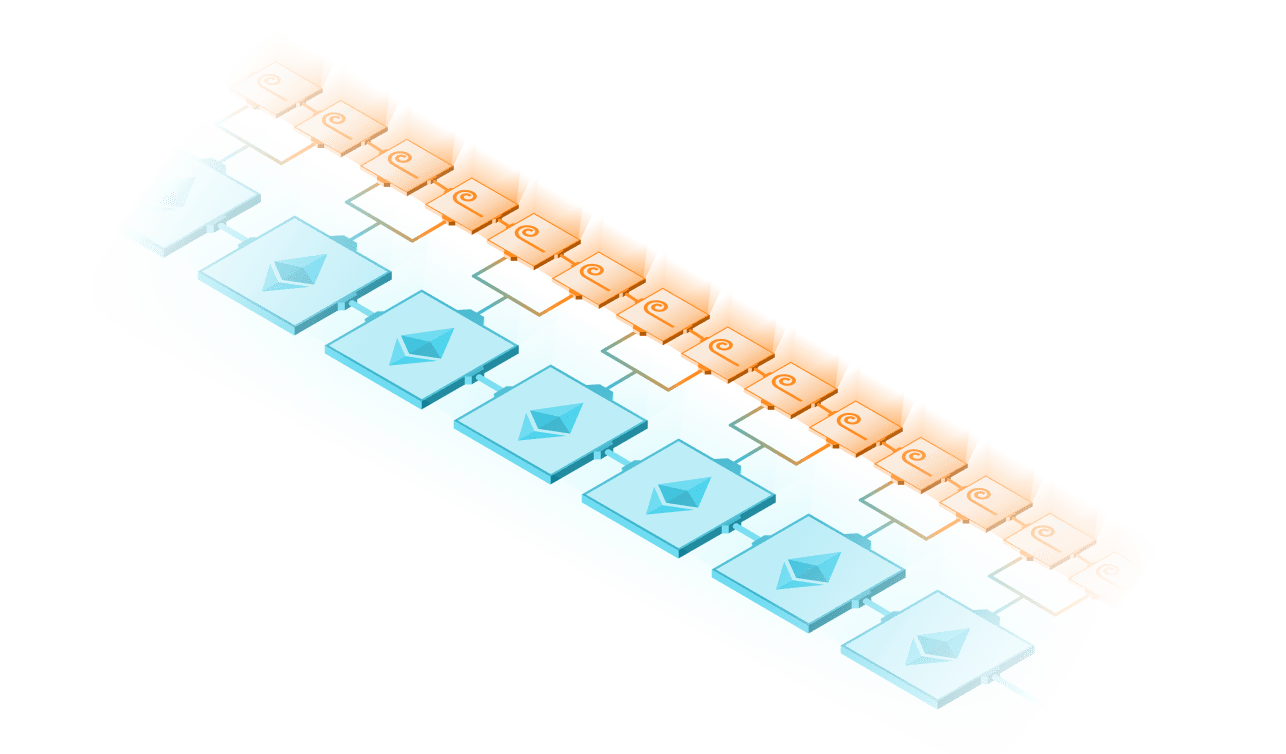Layer 2
Ethereum for anybody
Scaling Ethereum without compromising on security or decentralization.

loading…
TVL locked in layer ii (USD)
loading…
Average layer 2 ETH transfer fee (USD)
loading…
Layer ii TVL alter (30 days)
What is layer ii?
Layer 2 (L2) is a collective term to describe a specific set of Ethereum scaling solutions.
A layer 2 is a split up blockchain that extends Ethereum and inherits the security guarantees of Ethereum.
Now let’s dig into it a bit more, and to do this nosotros need to explain layer ane (L1).

What is layer 1?
Layer i is the base blockchain. Ethereum and Bitcoin are both layer 1 blockchains because they are the
underlying foundation that various layer ii networks build on top of. Examples of layer 2 projects include “rollups” on Ethereum and the Lightning Network on peak of Bitcoin. All user transaction action on these layer 2 projects can ultimately settle dorsum to the layer one blockchain.
Ethereum too functions as a data availability layer for layer 2s. Layer ii projects volition post their transaction data onto Ethereum, relying on Ethereum for information availability. This information can exist used to get the state of the layer 2, or to dispute transactions on layer 2.
Ethereum equally the layer 1 includes:
-
A network of node operators
to secure and validate the network -
A network of cake producers
-
The blockchain
itself and the history of transaction information -
The consensus machinery
for the network
Yet confused on Ethereum?
Larn what Ethereum is.

Why do we need layer 2?
Three desirable properties of a blockchain are that information technology is
decentralized, secure, and scalable. The blockchain trilemma states that a simple blockchain architecture tin can only achieve two out of 3. Want a secure and decentralized blockchain? You lot demand to sacrifice scalability.
Ethereum has reached the network’southward electric current chapters with 1+ 1000000 transactions per day and high demand for each of these transactions. The success of Ethereum and the need to apply it has caused gas prices to rise substantially. Therefore the need for scaling solutions has increased in demand as well. This is where layer two networks come in.
Scalability
The main goal of scalability is to increase transaction speed (faster finality) and transaction throughput (higher transactions per second) without sacrificing decentralization or security.
The Ethereum customs has taken a stiff stance that it would not throw out decentralization or security in society to calibration. Until sharding, Ethereum Mainnet (layer 1) is only able to procedure roughly 15 transactions per second. When demand to employ Ethereum is high, the network becomes congested, which increases transaction fees and prices out users who cannot afford those fees. That is where layer 2 comes in to scale Ethereum today.
More on Ethereum’s vision
Benefits of layer ii
Lower fees
Past combining multiple off-chain transactions into a single layer one transaction, transaction fees are massively reduced, making Ethereum more accessible for all.
Maintain security
Layer 2 blockchains settle their transactions on Ethereum Mainnet, assuasive users to benefit from the security of the Ethereum network.
Expand utilize cases
With higher transactions per second, lower fees, and new applied science, projects volition expand into new applications with improved user experience.
How does layer 2 work?
As we mentioned above, Layer two is a commonage term for Ethereum scaling solutions that handle transactions off Ethereum layer 1 while all the same taking reward of the robust decentralized security of Ethereum layer 1.
A layer ii is a separate blockchain that extends Ethereum. How does that work?
A layer 2 blockchain regularly communicates with Ethereum (by submitting bundles of transactions) in society to ensure it has like security and decentralization guarantees. All this requires no changes to the layer one protocol (Ethereum). This lets layer one handle security, data availability, and decentralization, while layer 2s handles scaling. Layer 2s take the transactional brunt abroad from the layer 1 and post finalized proofs dorsum to the layer 1. By removing this transaction load from layer 1, the base layer becomes less congested, and everything becomes more than scalable.
Rollups
Rollups are currently the preferred layer 2 solution for scaling Ethereum. By using rollups, users tin can reduce gas fees by upward to 100x compared to layer 1.
Rollups bundle (or ’ringlet upward’) hundreds of transactions into a single transaction on layer 1. This distributes the L1 transaction fees across everyone in the rollup, making information technology cheaper for each user. Rollup transactions get executed outside of layer one but the transaction data gets posted to layer 1. Past posting transaction data onto layer 1, rollups inherit the security of Ethereum. In that location are two different approaches to rollups: optimistic and zero-knowledge – they differ primarily on how this transaction data is posted to L1.


Optimistic rollups
Optimistic rollups are ‘optimistic’ in the sense that transactions are assumed to be valid, but tin can be challenged if necessary. If an invalid transaction is suspected, a mistake proof is ran to see if this has taken place.
More on optimistic rollups

Cipher-noesis rollups
Zero-knowledge rollups use validity proofs where transactions are computed off-chain, then compressed data is supplied to Ethereum Mainnet as a proof of their validity.
More than on ZK-rollups
Practise your ain research: risks of layer 2
Since layer 2 bondage inherit security from Ethereum, in an ideal world, they are as safe as L1 Ethereum. However, many of the
projects are still immature and somewhat experimental. Afterward years of research and development, many of the L2 technologies that will scale Ethereum launched in 2021. Many projects still take additional trust assumptions as they work to decentralize their networks. Always practice your own inquiry to decide if you lot’re comfy with whatsoever risks involved.
For more than information on the technology, risks, and trust assumptions of layer 2s, we recommend checking out L2BEAT, which provides a comprehensive risk assessment framework of each projection.
Get to L2BEAT
Employ layer 2
Now that you lot empathise why layer 2 exists and how it works, let’south get you up and running!
Annotation:
When bridging over and using layer two, it is important to annotation that yous volition control the address for your EOA account (an account where just a single private key controls the account) just like on Ethereum Mainnet. However, if yous are using a contract account, such equally Gnosis Safe or Argent, you will not accept control over this accost on a layer 2 until you lot redeploy your contract account to that address on the layer two. If you are bridging or sending funds to a contract account, and yous practise non control this accost for the contract account, your funds may be lost.
Generalized layer 2s
Generalized layer 2s comport only like Ethereum — simply cheaper. Anything that you can do on Ethereum layer 1, you can likewise exercise on layer 2. Many dapps have already begun to migrate to these networks or have skipped Mainnet altogether to deploy straight on a layer 2.

Boba Network
Boba is an Optimistic Rollup originally forked from Optimism which is a scaling solution that aims to reduce gas fees, amend transaction throughput, and extend the capabilities of smart contracts.
Note:
State validation in development
Boba Network
Span
Explore
Boba Network
Application specific layer 2s
Application specific layer 2s are projects that specialize in optimizing for a specific application space, bringing improved operation.

Loopring
Loopring’s zkRollup L2 solution aims to offer the same security guarantees as Ethereum mainnet, with a large scalability boost: throughput increased by 1000x, and toll reduced to just 0.1% of L1.
Loopring
Span
Explore
Loopring

zkSync
zkSync is a user-centric zk rollup platform from Affair Labs. Information technology is a scaling solution for Ethereum, already alive on Ethereum mainnet. It supports payments, token swaps and NFT minting.
zkSync
Bridge
Explore
zkSync

ZKSpace
The ZKSpace platform consists of three principal parts: a Layer two AMM DEX utilizing ZK-Rollups engineering science called ZKSwap, a payment service called ZKSquare, and an NFT marketplace called ZKSea.
ZKSpace
Bridge
Explore
ZKSpace

Aztec
Aztec Network is the first private zk-rollup on Ethereum, enabling decentralized applications to access privacy and scale.
Aztec
Span
Explore
Aztec
A notation on sidechains, validiums, and culling blockchains
Sidechains and validiums
are blockchains that allow avails from Ethereum to be bridged over and used on another blockchain. Sidechains and validiums run in parallel with Ethereum, and collaborate with Ethereum through bridges, but they do not derive their security or data availability from Ethereum.
Both scale similarly to layer 2s – they offer lower transaction fees and college transaction throughput – but have different trust assumptions.
More info on sidechains
More info on validiums
Some
layer 1 blockchains
take higher throughput and lower transaction fees than Ethereum. These alternative layer 1s have had to
sacrifice on security or decentralization
in order to achieve higher transactions per second and lower transaction fees.
The Ethereum ecosystem is firmly aligned that
layer 2 scaling is the only way to solve the scalability trilemma
while remaining decentralized and secure.
How to get onto a layer two
There are ii primary ways to go your assets onto a layer 2: bridge funds from Ethereum via a smart contract or withdraw your funds on an substitution directly onto the layer 2 network.
Funds in your wallet?
If you’ve already got your ETH in your wallet, you lot’ll need to use a bridge to motion information technology from Ethereum Mainnet to a layer 2.
More on bridges
Select L2 you desire to bridge to
Funds on an exchange?
Some centralized exchanges now offer direct withdrawals and deposits to layer 2s. Check which exchanges support layer 2 withdrawals and which layer 2s they back up.
Y’all’ll too demand a wallet to withdraw your funds to.
Detect an Ethereum wallet.
Check exchanges that support L2

Tools to be effective on layer 2
Information

L2BEAT
L2BEAT is a nifty resources for looking at technical risk assessments of layer 2 projects. We recommend checking out their resources when researching specific layer ii projects.
Go

L2 Fees
L2 Fees lets yous see the current toll (denominated in USD) for doing transactions on different layer 2s.
Go

Chainlist
Chainlist is a great resource for importing network RPC’s into supporting wallets. You will find RPC’s for layer two projects hither to aid become you connected.
Go
Wallet managers

Zapper
Manage your unabridged web3 portfolio from DeFi to NFTs and whatsoever comes next. Invest in the latest opportunities from one convenient place.
Go

Zerion
Build and manage your entire DeFi portfolio from one place. Detect the world of decentralized finance today.
Go

DeBank
Go along up with all the important happenings in the web3 world
Become
FAQ
Just every bit at that place is no ‘official’ Ethereum client, there is no ‘official’ Ethereum layer 2. Ethereum is permissionless – technically anyone can create a layer 2! Multiple teams will implement their version of a layer 2, and the ecosystem as a whole will benefit from a diverseness of blueprint approaches that are optimized for dissimilar use cases. Much like we have multiple Ethereum clients developed by multiple teams in social club to accept diversity in the network, this too will exist how layer 2s develop in the future.
Both optimistic and zero-knowledge rollups parcel (or ’roll upward’) hundreds of transactions into a single transaction on layer one. Rollup transactions get executed exterior of layer 1 but transaction information gets posted to layer one.
The principal difference is what data is posted to the layer 1 and how the data is verified. Validity proofs (used past zero-knowledge rollups) run the computations off-chain and mail a proof, whereas fault proofs (used past optimistic rollups) only run the computations on-chain when fault is suspected and must be checked.
At the moment, most ZK-rollups are application specific, in dissimilarity with optimistic rollups which have largely been generalizable.
More info on optimistic rollups
More info on naught-knowledge rollups
Yes. Currently in the Ethereum roadmap at that place are plans for shard chains. While these are in the roadmap, further scaling through layer ii networks is still necessary.
More info on sharding
Layer ii projects contain additional risks compared to holding funds and transacting direct on Ethereum Mainnet. For instance, sequencers may go down, leading you lot to have to wait to access funds.
We encourage you to do your own research before transferring significant funds to a layer 2. For more information on the applied science, risks, and trust assumptions of layer 2s, we recommend checking out L2BEAT, which provides a comprehensive gamble assessment framework of each project.
Blockchain bridges, which facilitate asset transfers to layer two, are in their early stages of development and information technology is probable that the optimal bridge pattern has non been discovered nonetheless. In that location take been recent hacks of bridges.
More on bridges
We desire to make certain nosotros list the best resources possible so users can navigate the layer 2 space in a safe and confident style. Nosotros maintain a framework of criteria for how projects are evaluated for inclusion.
View our layer 2 listing policy here.
Anyone is costless to suggest adding a layer two on ethereum.org. If there’s a layer 2 that we take missed, delight propose information technology.
Test your knowledge
Was this page helpful?
Source: https://ethereum.org/en/layer-2/
 RosyandBo.com Trusted Information and Education News Media
RosyandBo.com Trusted Information and Education News Media



